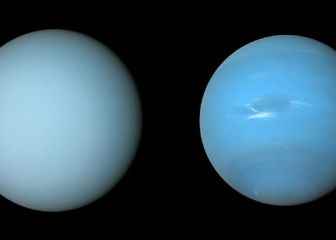Uranus and Neptune They have an obvious resemblance: their characteristic blue color. But between the two they differ in tonality, the second being darker. Thanks the hubble space telescopeNASA’s Infrared Telescope Facility and the Gemini North have managed to reveal the reason for this difference in the intensity of one over the other.
The University of Oxford, through a team of researchers, has developed a unique atmospheric model matching observations of both planets Of the solar system. Thanks to this, it has been possible to determine that the cause that explains the lighter hue of Uranus is haze, which accumulates in the planet’s stagnant, sluggish atmosphere. The model also brings to light the presence of a second, deeper layer, which when darkened reveals the dark patches in these atmospheres, such as the Great Dark Spot (GDS) that Voyager 2 observed in 1989.
Similarities
There are several characteristics that these planets have in common, such as similar masses, sizes, or atmospheric compositions. But through visible wavelengths, the clearly bluer color of Neptune on Uranus. What the experts consider is that the haze layer of both planets is thicker on Uranus, so it “whitens” its appearance. If this layer did not exist, both would look almost the same.
A conclusion reached by the model created by a team led by Patrick Irwin, Professor of Planetary Physics at the University of Oxford. With it, it has been possible to describe the aerosol layers in the atmospheres of Uranus and Neptune. Previous research on the upper atmospheres of these planets focused on the appearance only at specific wavelengths.
Exploration of aerosol layers
The new model provides a different view, as it consists of multiple atmospheric layers and it matches observations of the planets over a wide range of simultaneous wavelengths. In addition, the model includes mist particles in deeper layerswhich were previously thought to contain only ice clouds of methane and hydrogen sulfide.
“This is the first model to simultaneously fit observations of reflected sunlight from ultraviolet to near-infrared wavelengths. He is also the first to explain the difference in visible color between Uranus and Neptune.“, explains Professor Irwin in a statement from the Oxford University. This model consists of three layers of aerosols at different heights, with the middle layer being the key layer that affects colors. It is a layer of haze particles, thicker on Uranus than Neptune.
The researchers believe that on the two planets methane ice condenses on the particles in this layer, thereby dragging the particles deeper into the atmosphere in a methane snow shower. And how Neptune’s atmosphere is more active and turbulent than Uranus’s, experts believe that this planet is more efficient to shake these particles and produce that snow. Something that removes more haze and makes the layer thinner, giving Neptune a deeper blue color. “Explaining the color difference between Uranus and Neptune was an unexpected bonus!” celebrates Mike Wong, an astronomer at the University of California.
